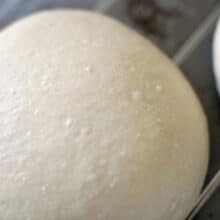When you start making your own pizzas from scratch, you’ll need to find a great dough recipe. There are plenty of them out there, so it takes a certain amount of trial and error to find the one that works for you. As you start researching and testing doughs, you’ll soon find recipes talking about using dough starters and making indirect versus direct doughs, you’ll come across terms like biga and poolish, and it can all get confusing pretty quickly.
So, we’ve put together this article to explain these different terms and help you understand the various processes involved. We’ll explain what biga is, why you might want to use it, and how it differs from other starters. And we’ll give you some tips for making an excellent biga pizza dough. If you get lost, check out the glossary at the bottom of the article for a quick explanation of the terms.
Let’s get started.
What Is Biga?
Biga is an Italian fermentation technique used to create indirect dough for baking. It’s especially popular with Italian-style breads and Neapolitan pizzas as it makes dough with a light texture, large air bubbles, and rich, complex flavors.
What Is Indirect Dough?
Indirect doughs have an extra step in their preparation process – the addition of a starter or preferment. This is a portion of yeast cultured dough made and left to rise and develop for several hours before being added to the main dough later. In comparison, a direct dough is made all at once.
Making an indirect dough takes longer and is a slightly more involved process, but it results in better, tastier bakes.
Are All Dough Starters The Same?
Dough starters are all similar but not the same. A variety of starters are used in the baking world, and they all have their roots in different baking methods and languages. This is one of the reasons this subject can be quite confusing when you first come across it. But it’s not as complicated as it seems.
Most starters and preferments are simple mixtures of yeast, flour, and water. The differences come from the ratios of ingredients, the type of yeast used, and the results they yield.
For example, in pizza baking, you’ll most likely come across three types of starter: biga, poolish, and sourdough. And the main difference between a sourdough starter and the others is that it’s made using wild or natural yeast rather than commercial yeast.
Wild yeast is trickier to work with and less dependable than commercial yeast, but it’s what gives sourdough bakes their unique flavor and aroma.
What’s The Difference Between Biga and Poolish?
There are a few differences between biga and poolish. The main one is the texture during the pre-fermentation. They both contain a mixture of flour, water, and commercial yeast, but poolish uses much more water resulting in a wetter, almost liquid consistency, while biga is a dryer and shaggy consistency. Whether using poolish or biga, once you finish mixing the preferment with the rest if the ingredients, they result in standard looking pizza dough.

Biga is popular in bakes requiring large, irregular air bubbles such as ciabatta and focaccia. Whereas poolish – despite its Polish origins – is revered in french baking and is used for pastries and french breads.
In addition, biga can take longer to ferment than poolish. This is why I do an 18-24 hour room temperature fermentation with biga, but my poolish recipe uses an 18-24 hour cold fermentation in the fridge. Poolish can also be combined with the main dough by hand, while with biga, it’s easier to use a mixer.
However, despite these differences, they both make excellent pizza doughs, and it would take a very refined palate to pick much difference in flavor between them. So the choice between them comes down to personal preference. The best way to choose between them is to try both, compare the method, texture, time, and results and choose your favorite.
Why Use Biga To Make Pizza Dough?
Using biga to make pizza is an additional step taken by chefs on the hunt for pizza perfection. Of course, you don’t have to do it, pizzas are often made with direct doughs, no starter or preferment, and they give tasty results. But if you’re looking for a way to take your bakes to the next level, adding biga to your dough is a great way to do that.
Using a biga essentially ages part of your dough, giving it extra time to develop and ferment, and this has a multitude of benefits. The process improves the structure of the dough resulting in light, airy bakes with wonderfully bubbled crusts. The extra development time creates rich flavors and aromas in the dough, giving complexity to the taste that direct doughs cannot achieve. Bread and pizza made with biga also contain less gluten and are more easily digestible than those without, plus they have a longer shelf life.
How To Make Biga Pizza Dough
Making a biga dough is a simple process, there are only three ingredients, flour, yeast, and water. The exact qualities will depend on the recipe you are using, but the ratio of flour to water is generally 2:1. So if you use 500g of flour, you will add 250g of water.
Combine the three ingredients and roughly mix – but don’t knead – them together until all of the flour is gone from the sides of the bowl, and you’re left with dough with a rough, clumpy texture.
Cover the bowl and leave to develop at room temperature for 16- 20 hours or in the fridge for 24- 36 hours.
Once ready, combine the biga with the rest of your dough ingredients. The easiest way to do this is in a spiral mixer, as the consistency of the biga makes it tricky to combine with the rest of the ingredients by hand.
Once your dough has reached a smooth and silky consistency, remove it from the mixer, fold by hand for 5 minutes, then rest for 15-20 minutes.
Separate the dough into balls, tray up, and leave for 1-2 hours at room temperature. Your dough is then ready to bake. However, if you want an even better flavor, leave the dough balls in the fridge overnight before baking.
Remove dough from the fridge and allow it to return to room temperature before shaping and baking your delicious biga pizza!
Top Tips For Excellent Biga Pizza Dough
The exact time recommended for your biga to develop will change with every recipe you read. Plus, the time will vary depending on the conditions of your kitchen since ‘room temperature’ is different depending on the room in question. So rather than setting an exact timer, get used to keeping an eye on your biga to judge when it’s ready – the more often you make it, the better you’ll get at judging it.
Try not to rush the fermentation process. The longer you leave it, the better the structure and flavor of the final product.
You’ll know when your biga is ready because it will have doubled in size and changed consistency from dry and scraggy to soft and stretchy. It should also be giving off a pungent, slightly acidic aroma.
Making a starter adds time to your pizza baking process, and you won’t always have the time to spare. So why not have some biga pre-made and ready to go? Biga can be frozen for up to 3 months, so next time you make some, make extra, pop it in the freezer and take it out as and when you need it. Just let it return to room temperature before combining it with your main dough.
Because biga contains less water than poolish, you have more flexibility over what percentage of your final dough the starter makes up. A poolish should never exceed 50% of the total, but your biga can make up much more. In fact, both Ooni and Gozney – two industry leaders in backyard pizza cooking – have 100% biga recipes, where all the flour in the whole dough is part of the biga. So don’t be afraid to try different recipes and ratios!
Glossary
Direct dough is the name given to doughs that are made all at once. It is the simplest and quickest method of dough making as all the ingredients are mixed together at one time.
Indirect dough is the term for doughs that involve starters or preferments. They are made in two stages. The preferment is made first and then added to the main dough later. It’s a lengthier process but results in more delicious breads and pizzas.
Starter or preferment is a portion of yeast-cultured dough made before the main bread or pizza dough. It is allowed to develop before being added to the main dough, resulting in a more complex flavor, better texture, longer shelf life, and more easily digestible bake.
Biga is a preferment of Italian origin, common in pizzas and Italian breads.
Poolish is a preferment invented in Poland and common in Neapolitan pizzas and french baking. It contains more water than biga and has a liquid consistency.
Sourdough starter is a preferment that uses wild or natural yeast rather than commercial yeast. It is more time-consuming to make and maintain than biga and poolish.
Commercial yeast is a strain of yeast that has been selected for its excellent ability to make bread rise and has been cultivated and mass-produced for that purpose. You can buy it easily and cheaply in most supermarkets and add it to your baking in specific measured amounts.
Natural or wild yeast occurs naturally and is found almost everywhere. When making a sourdough starter, most of the yeast will come from the flour, but some will also come from the water, air, equipment used, and even the hands of the baker who makes it. For this reason, it is unique to its environment, and bread made from it will have a unique flavor and aroma depending on where the yeast was ‘caught’.

Easy Biga Pizza Dough
Equipment
Ingredients
Preferment (Biga)
- 500 g 00 flour Caputo "Pizzeria" is the ideal choice.
- 250 g Water
- 2 g Instant Dry Yeast Avoid the packets in the grocery store if you can (they'll work in a pinch, but don't get the "pizza crust" one). I really like SAF Instant or Caputo yeast.
Final Dough
- 75 g Water
- 12 g Salt
- 5 g *Diastatic Malt (OPTIONAL) Only use this in ovens below 700F. Helps with browning.
Instructions
Biga (Day 1)
- In a glass measuring cup or microwavable bowl, heat water in the microwave for 20 seconds; this should result in a temperature of 80-90F.
- If you're using Fresh or Active Dry Yeast, mix the yeast into the water and let sit for 2 minutes. If you're using Instant Dry Yeast (IDY), proceed to the next step. Note: Caputo yeast is labeled as Active yeast, but does not need to be activated in water (works as IDY).
- Add the flour and yeast (if using IDY) to a large bowl. Slowly pour the water (preferment section only!) into the bowl of flour and mix well with hands, or a spoon, until fully incorporated and no dry flour remains. It will be a very shaggy texture and will not form into a dough – don't worry, this is what we want!
- Cover the bowl with saran wrap tightly. Poke a small hole in the center of the film with a pen. Allow to sit at room temperature for 18-24 hours.
Dough (Day 2)
- Transfer the Biga to the bowl of a stand mixer. Add the salt, malt (if using), and remaining water (Final Dough section) and mix by hand until beginning to incorporate into a dough. Fit the mixer with a dough hook and turn on medium, mixing until dough is smooth and elastic, 5-8 minutes.
- Remove dough from bowl and knead by hand, 2 minutes. Flip the bowl over top of the dough and allow to rest for 20 minutes; you will notice the gluten is stronger after the rest. Divide the dough into equal pieces, roughly 270g each. Knead into a taut ball before placing in a lightly oiled bowl or proofing container, seam-side down. Cover the bowl with an air-tight lid or saran wrap and place in the refrigerator to cold ferment for another 18-24 hours.
Pizza Day (Day 3)
- Remove the dough from the refrigerator and allow to come to room temperature, at least 2 hours (assuming 70F; +/- an hour depending on room temp). With a lightly floured dough scraper/cutter, gently pick up a doughball and place it into a bowl with 50/50 semolina and 00 flour. Lightly coat both sides to prevent stickiness before continuing to stretch and bake.


